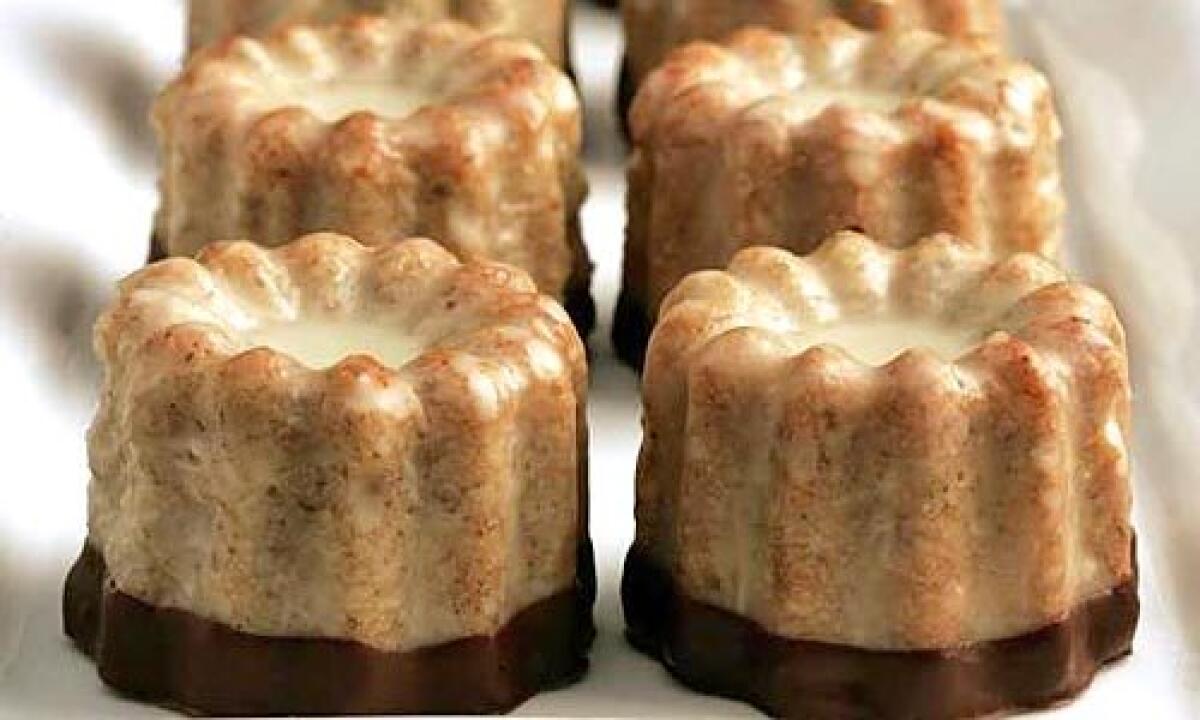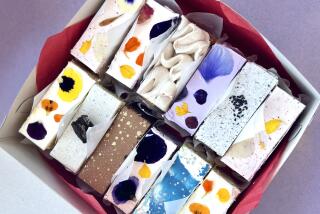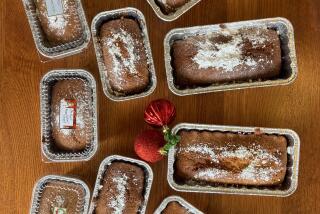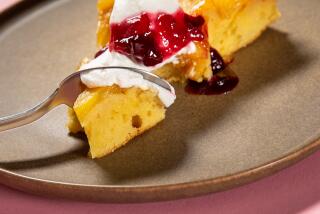Recipe: Valerie Confections tea cakes

- Share via
Lemon-myrtle, lavender-Earl Grey, hazelnut-orange -- the selection of tea cakes from Valerie Confections screams spring.
Assistant Food editor Betty Hallock is a fan: “They’re moist, dense and not too sweet -- and not overly precious either,” she says. “The hazelnut-orange tea cakes are rich with nutty flavor and bright with candied orange peel. And that citrusy-crackly-zingy glaze is, well, the icing on the cake.”
In the batter, Valerie uses candied Seville orange peel from junetaylorjams.com. You also can make candied orange peel; included below is a recipe from test kitchen director Donna Deane. If you’re also making your own hazelnut paste, the recipe requires some advance prep. But these amazing little cakes are worth the time and effort -- and you’ll have plenty of them for a party.
Valerie’s hazelnut-orange tea cakes
Total time:
1 hour, 10 minutes plus cooling time (not including time for the hazelnut paste and candied orange peel, which requires overnight drying)Servings: 36 cakes
Note: Adapted from a recipe by Valerie Gordon of Valerie Confections. You can use purchased hazelnut paste (available at www.lepicerie.com and www.bernardcallebaut.com) and good-quality candied orange peel. This recipe calls for 2 1/4 -inch cannelé or 2-inch baba molds (silicone or metal). Cannelé molds are available at Sur La Table stores, Surfas in Culver City and at www.cheftools.com, www.cooking.com and www.amazon.com. Baba molds are available at Sur La Table stores and at www.cooking.com and www.amazon.com.
Hazelnut paste8 ounces roasted hazelnuts, coarsely chopped
2 1/2 tablespoons egg whites (from about 2 eggs)
1 cup powdered sugar
1 teaspoon hazelnut liqueur
In a food processor or blender, finely grind the nuts until mealy (in batches, if necessary). Add the egg whites, powdered sugar and liqueur and blend until fully combined and a paste forms. Remove the paste and store, tightly wrapped in plastic, in the refrigerator. It will keep for up to 2 weeks. Makes 13 ounces.
Candied orange peel
2 California navel oranges
4 cups sugar
1. Bring three 3-quart pots of water to a boil. Use a small knife to score the oranges into quarters (cut through the peel and pith but not through the fruit). Remove the peel; set aside the fruit for another use.
2. Add the peel to the first pot of water and simmer 2 minutes and then drain. Repeat two more times in a new pot of boiling water.
3. Drain the blanched peel on paper towels and pat dry. When cool enough to handle, cut the ends off each piece of peel so that you have straight edges, then cut it crosswise into quarter-inch strips.
4. In a large pot, combine 4 cups sugar and 4 cups water. Bring to a boil and simmer 5 minutes, until clear. Add the cut-up peel to the simple syrup and simmer gently 2 hours until the fruit looks translucent. As the peel is simmering, skim off any foam from the syrup.
5. Lightly oil a cooling rack and place waxed paper underneath. Use a slotted spoon to remove the peel from the syrup and place the strips in a single layer on the rack. Let the candied peel dry overnight. It will keep for several weeks tightly sealed in an airtight container in a cool place. Makes 1 1/2 cups.
Tea cakes
1 cup plus 2 tablespoons butter, diced (at room temperature), plus additional for greasing the molds
1 1/2 cups plus 2 1/2 tablespoons flour
2 1/4 cups hazelnut flour (or finely ground hazelnuts)
2 teaspoons salt
2 cups minus 1 tablespoon sugar
11.3 ounces (1 cup plus 5 tablespoons packed) hazelnut paste
6 eggs plus 6 egg yolks
1 teaspoon vanilla
1/2 teaspoon orange oil
2 tablespoons finely chopped candied orange peel
1/4 cup plus 2 tablespoons orange juice
3 3/4 cups loosely packed (12 ounces) sifted powdered sugar
1 pound good quality semisweet chocolate, chopped
1. Heat the oven to 350 degrees and lightly grease the cannelé or baba molds.
2. In a medium bowl, combine the flour, hazelnut flour and salt. Set aside.
3. In the bowl of a food processor with the paddle attachment, or in a large bowl with a fork, mix together the sugar and hazelnut paste until the paste is broken up and combined with the sugar. It should be a mealy consistency. Continuing with the paddle attachment, or with a hand mixer, add in the eggs, yolks, vanilla, orange oil and orange peel. Slowly mix in the dry ingredients until combined, then mix in the butter until incorporated into the batter.
4. Place the molds on a sheet pan and fill each two-thirds full of batter. Place the pan in the oven and bake for 25 to 30 minutes (times will vary depending on the types and thickness of the molds) until the tops are rounded, golden and a toothpick inserted into the middle of the cake comes out clean. Remove the tray from the oven, and allow the molds to rest 5 minutes on a rack before unmolding the cakes. Cool the cakes completely on the racks.
5. Prepare the glaze: Place 2 tablespoons of orange juice in a large bowl and slowly add some of the powdered sugar, whisking together to fully incorporate. Continue to add orange juice and sugar alternately until all juice and sugar have been added and the glaze is smooth.
6. When the cakes are cool,trim the bottoms of the cakes (the rounded ends) so they are even and flat. Carefully dip each cake into the glaze to coat the top and sides, then invert (so that they’re upright) onto the rack until the glaze is dry. Repeat with all of the cakes.
7. Melt the chocolate gently in a double boiler or in a medium metal bowl set over a pan of simmering water (make sure the water does not touch the bottom of the bowl). Stir the chocolate occasionally so that it melts evenly.
8. When the cakes are dry,carefully dip the bottom of each cake into the chocolate so that the bottom and a small portion of the sides are evenly covered. Remove the cake from the chocolate, shaking gently to allow any excess chocolate to drip from the cake back into the bowl. After each cake is coated, place it on a large sheet of parchment paper, and continue to coat a few more cakes. When a few cakes have been coated and the chocolate is just starting to set (it will not be dry), move each of the coated cakes to another sheet of parchment paper -- this will remove the “footprint” (excess chocolate that has pooled around the cake) and allow the cake to dry with clean edges. If the chocolate starts pooling again around any cakes, simply move them again to a clean space on the parchment paper. Repeat with the remaining cakes. Allow the cakes to dry completely. The cakes will keep for 1 week, refrigerated.
Each cake: 338 calories; 5 grams protein; 42 grams carbohydrates; 2 grams fiber; 18 grams fat; 5 grams saturated fat; 84 mg. cholesterol; 145 mg. sodium.
More to Read
Sign up for The Wild
We’ll help you find the best places to hike, bike and run, as well as the perfect silent spots for meditation and yoga.
You may occasionally receive promotional content from the Los Angeles Times.











